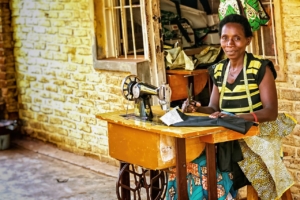Updates on SDG 15 in Rwanda
 Rwanda is in the process of healing the deep scars that genocide, a lacking international response and associated conflict has left in their wake. As a country, it is making significant strides toward higher levels of equity and poverty reduction. To tackle these major issues, emphasis has been placed on addressing the drivers of suffering, namely the protection of natural resources, support of industry and food security. Updates on SDG 15 in Rwanda, which encourages the protection, restoration and management of the species and habitats in terrestrial and freshwater ecosystems, have been key to contributing to Rwandan welfare.
Rwanda is in the process of healing the deep scars that genocide, a lacking international response and associated conflict has left in their wake. As a country, it is making significant strides toward higher levels of equity and poverty reduction. To tackle these major issues, emphasis has been placed on addressing the drivers of suffering, namely the protection of natural resources, support of industry and food security. Updates on SDG 15 in Rwanda, which encourages the protection, restoration and management of the species and habitats in terrestrial and freshwater ecosystems, have been key to contributing to Rwandan welfare.
What Are the SDG 15 Activities Taking Place in Rwanda?
The United Nations Development Programme (UNDP), the United Nations Environment Programme (UNEP), the United Nations Educational, Scientific and Cultural Organisation (UNESCO) and the United Nations Human Settlement Programme (UNHSP) have partnered with several on-the-ground partners like the Rwanda Ministry of Environment and Natural Resources, African Development Bank and Rwanda Environment Management Authority to implement initiatives that support SDG 15 across the country.
Several of these initiatives began in 2018 and ended this year, making it an ideal time to reflect on the updates on SDG 15 in Rwanda. These activities have supported scientific studies and enhanced natural resource sustainability and community resilience. They have also undertaken ecosystem restoration and reduced poverty.
The National Strategy for Transformation (NST) is a program that will run from 2017–2024, working toward the first targets in the country’s Vision 2050 plan. It focuses on poverty alleviation through economic and social transformation and transformation of governance. Activities like the multi-sectoral Green Growth and Climate Resilient Strategy (GGCRS) prioritize welfare by focusing on the environment. This translates to direct, tangible benefits. Rwanda’s GDP per capita has grown to $1,030 USD, a national GDP growth of 6.2%.
Rwanda’s government has pledged two million hectares of forest restoration by 2030. It has already reached its target of covering 30% of the country with forests. This is a key step for the welfare of Rwandan communities since forest resources are widely used. In fact, more than 94% of Rwandans rely on wood as a main source of energy. Many also generate income through the country’s forests. Freshwater ecosystems are being systematically managed, and nationwide campaigns encourage people to use and manage freshwater resources more sustainably.
The Protection of Natural Resources and All Life on Rwandan Land
Natural resource health is a defining factor of welfare across the world. The ability to generate income, access the mental health benefits of nature and directly benefit from resource use are all fundamental reasons to properly manage and care for the natural environment.
Rwanda is home to roughly 40% of all species of African mammals—more than a thousand species of birds, hundreds of reptiles and amphibians and nearly 6,000 species of plants. Some of these, like the charismatic mountain gorilla, are only found in two other countries: the DRC and Uganda. The survival of these plants and animals also depends on the welfare of Rwanda’s terrestrial habitats.
From chimpanzees to leopards and forests to savannahs, the updates on SDG 15 in Rwanda have protected many species and habitats against several compounding pressures that currently threaten their existence and health. In one case, the mountain gorilla has made a promising conservation come-back. The population has grown from only a few hundred individuals in 2010 to more than a thousand today. This has directly impacted the communities in Rwanda. Community-based tourism programs depend on the health of mountain gorilla populations and other captivating species. These programs further improve the welfare of local communities by funding development projects and supporting the development of sustainable incomes.
How SDG 15 Supports Rwandan Industry and Food Security
The industries that SDG 15 supports—namely agriculture, forestry and fisheries—account for 29% of Rwanda’s total GDP, which reached record profit levels in 2019. About 47% of Rwanda’s land is suitable for agriculture, and 66.5% of the population works in agriculture. This makes it a popular choice for income generation.
Roughly 3.9 million Rwandan farmers and their families depend on the health and proper management of land for their survival. These individuals and communities consistently confront issues addressed by SDG 15, including habitat degradation, land stakeholdership issues and soil erosion.
As of 2022, 82% of Rwanda’s population is recorded as living rurally. An enormous 80% of these individuals also participate in subsistence farming. These farmers and their families are wholly dependent on the health of the country’s land. By maintaining and protecting land, the government of Rwanda can address the needs of its farmers and agricultural sector. It can also support the food security of its subsistence communities and simultaneously improve individual poverty levels.
Looking Forward
Through the management of terrestrial and freshwater ecosystems, the Rwandan government ensures the survival of its major economies and the well-being of its citizens. The health and utility of Rwandan land are so integral to the future of the country that agriculture, linked to the generation of wealth, has been named a pillar in Rwanda’s national development strategy: Vision 2050.
Future work on the SDGs in Rwanda will likely have profound effects on both wildlife and community welfare. As a land-locked country, the well-being and management of terrestrial and freshwater ecosystems are imperative to ensuring the survival and resilience of all life.
– Mirali Shukla
Photo: Pixabay
